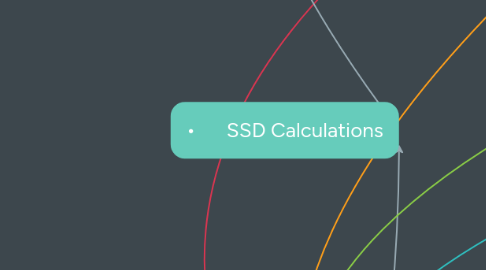
1. mala mia ajldlakj
1.1. giugkjk
1.1.1. kjhkj
2. • Inverse Square Law
2.1. • Inverse Square Factor (ISF)
2.1.1. • This factor adjusts the dose rate at an SSD other than nominal
2.1.1.1. ISL=((SSD1+dmax)/(SSD2+dmax) )^2
2.2. • intensity of radiation decreases invesely with the square of the distance from a point source
2.2.1. I1/I2 =(d2^2)/(d1^2 )
3. • Mayneord F factor
3.1. • Used to convert %DD from nominal SSD to treatment SSD
3.2. F=((SSD1+depth)/(SSD2+depth) )^2((SSD2+dmax)/(SSD1+dmax) )^2
3.2.1. this is multiplied by the nominal PDD to find extended SSD's PDD
4. • %DD (Percentage Depth Dose)
4.1. • Dose at a given depth at the reference point, usually chosen at dmax
4.2. • accounts for scatter, attenuation, and inverse square law
4.3. • %DD= (dose at depth)/ (dose at dmax) x 100
4.4. • Effects on %DD
4.4.1. • %DD ↓ with ↑ depth (beam attenuation)
4.4.2. • %DD ↑ with ↑ beam energy (higher beam has a higher penetrating factor)
4.4.3. • %DD ↑ with ↑ SSD
4.4.4. • %DD ↑ with ↑ field size (the dose to a point will increase due to scatter from collimator and in phantom
5. • Cobalt- 60 (Co-60)
5.1. • Time
5.1.1. • Field Size Dependent (FSD or Sc)
5.1.1.1. • Used to calculate dose for a field size other than 10x10
5.1.2. • BackScatter Factor (BSF or Sp)
5.1.2.1. • Used to take a dose from mini-phantom to dose in patient
5.1.3. • Dose Rate (cGy/min)
5.1.3.1. • Nominal
5.1.3.2. • 10x10 field
5.1.3.3. • 80 cm SSD
5.1.3.4. • dmax= .5cm
5.1.3.5. • in air (miniphantom)
6. • Linear Accelerator
6.1. Monitor Units
6.1.1. • Dose Rate (1cGy/MU)
6.1.1.1. • Nominal
6.1.1.1.1. • 10x10 field size
6.1.1.1.2. • 100 cm SSD
6.1.1.1.3. • dmax
6.1.1.1.4. • in phantom
6.1.2. • Collimator Scatter (Sc)
6.1.2.1. • used for when the field size changes, and scatter needs to be accounted for
6.1.3. • Phantom Scatter (Sp)
6.1.3.1. • It accounts for when the beam is in the patient
6.1.4. • Output Factor (OPF)
6.1.4.1. • accounts for treatment size and phantom
6.1.5. OPF for Extended SSD
6.1.5.1. calculate what the field size is at nominal SSD use the OPF for that field
6.1.5.1.1. this gives us the collimator scatter but not the phantom scatter
6.1.5.2. We must divide the Peak Scatter Factor (PSF) from both SSD's
6.1.5.2.1. OPFssd2= OPFssd1 (PSFssd2/PSFssd1)
6.1.6. Sc and Sp for extended SSD
6.1.6.1. If you do not use the OPF you can use Sc and Sp
6.1.6.2. Sc is used at nominal distance
6.1.6.3. Sp is used at extended
7. Field Size
7.1. FSD's, Sc's, and OPF's are for nominal field sizes, when treatment at extended SSD one must calculate the appropriate field size to look up the correct FSD, Sc, or OPF
7.1.1. Formula: (SSD1/SSD2)=(Field size 1/ Field Size 2)

